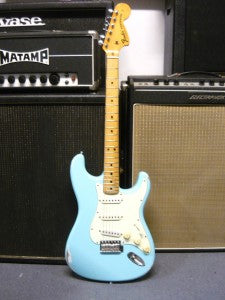1971 Strat refret pt 2
Share
OK folks, so after a ........... challenging refret (see last post) the guitar was ready to go together. The body was a "relic'ed" alder body from one of the US parts places. I can't remember which company the customer said.
There was a second vibrato (or "TREMOLO" as Leo mistakenly called it) with narrower spacing with the body as the vibrato on the body had a far too wide string spacing causing the outside two strings to run off the edge of the fretboard by the end of the neck.
With the neck and vibrato fitted properly it was a new nut next. The bone blank was chosen to suit nut slot width and radius and then sanded down to the right width to suit the neck. Personally I prefer bone and use it on all my own guitars. I don't have issues with some synthetic nut materials but if my guitar can't have a zero fret, I'll take a bone nut next.
With the width taken care of it's down to getting the slot centres right. A badly spaced nut is one of the most frustrating things when you get a new nut fitted. If the nut is too high, it can be taken down, if it's too low it can be shimmed but if the string spacing is out, you need a new nut .......... again.
Once the spacing is sorted it's down to getting the slot heights right. I highly recommend getting yourself some nut slot files if you're going to do this more than a couple of times yourself. They save time and frustration.
Once the slots are "nearly" done I take the nut back out and lower the top and polish it to a nice shine. Bone is easy to work with generally and will polish like ivory.
With the nut polished and "nearly" right, it get's glued into the nut slot and left to dry. Once set, I do a close set up for action and truss rod adjustment and then start getting the nut slot heights right.
Put the outside 2 E strings on and line the neck up properly and then string the guitar to pitch. I get the action pretty much right and then play it a little. NOW, we start filling the slots deeper making sure to check regularly how high they are. Remember, don't go too low or you may have to start again.
Once the slots are the right height I complete the set up. Adjusting action and intonation as it all settles in. Like I said in one of my previous posts a refret can change the way a neck reacts and feels and I prefer to let freshly refretted necks settle in for more than overnight like a standard set up. This one sat there fully set up for a weekend and then I looked at it again. It still looked very good and just needed a little "tweaking"
With it all settled in and set up, it's ready to go back to the customer.
This is a big job and like I've said can change the feel of your guitar. If you're concerned about getting this done, talk to the repairer BEFORE getting the work done. If they're not concerned, you should be, and you want to know what "might" happen before, not after.
Don't get me wrong. Refrets are a common repair and an essential part of maintaining a guitar. Let's face it, a 50 year old guitar with no fret wear hasn't been played, and where's the fun in that. Refrets are an essential part of a well played and loved guitar and there seems to be "a little" less stigma about vintage guitars with good quality refrets in attitude and price, which is good to see.
To me, a well repaired guitar that's a great playing and sounding guitar is worth infinitely more than a completely original guitar with no wear that plays or sounds like a dog, which is probably why it has no wear. Most of my favorite Gibsons have repaired headstock breaks. Most of my Fenders are parts guitars or repaired vintage ones. They're cheaper to buy, you can play them without worrying about them and you can trade them on when a better one comes along.
Come and get it Watto.









